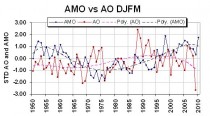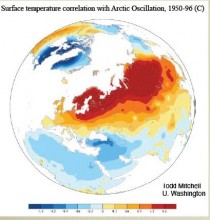Olivier Lejeune, Platts, GWPF
Colder winters could become the norm in Europe over the next 20 to 40 years, US-based forecaster Weather Services International said Tuesday.
“We have recently noticed a change in [weather] patterns back to what we had in the 1950s and 1960s in Europe… We’ve had three cold winters in a row in the UK,” WSI’s chief meteorologist Todd Crawford told Platts.
“We believe there is a strong likelihood that it’s going to hang around for the next 20 to 30 years.”
If true, the findings could have important implications for the European energy markets, where demand typically increases during winter because of higher heating and lighting requirements.
Peak electricity demand hit an all-time record in France at the beginning of December, and was near its historic record in the UK, amid temperatures that were more than 10 degrees Celsius below the seasonal norm.
Natural gas and gasoil demand also soared. Behind the freezing temperatures is the North Atlantic Oscillation, a climatic phenomenon that normally sends wind from western European countries to the east, keeping cold air from the Arctic at bay. But in December the current was flowing in the opposite direction, bringing cold Arctic air to western European regions and sending energy demand to fresh highs.
“During the last 30-40 years, the NAO was predominantly positive resulting in much warmer, wetter winters,” Crawford said. “Starting in 2008, however, the NAO has sharply reversed to a much more negative state and the result has been quite notable with three straight cold winters in the UK.”
Weak solar activity

Enlarged here.
WSI said the reversal in the NAO could be due to three factors: recent cyclical changes in North Atlantic ocean temperatures; climate change, which results in warmer Arctic air and sends cold air southward to Europe; and a “weak” solar cycle.
Icecap Note: As we showed in this post here, the North Atlantic Oscillation, an important component of the overall arctic oscillation varies with the ocean temperature tripole in the Atlantic, known as the AMO or Atlantic Multidecadal Oscillation. When the Atlantic is in the warm positive AMO mode as is currently the case, the NAO and AO tend to be more negative.

Enlarged here.
When the AMO is positive with warm water in the North Atlantic and in the Tropical Atlantic, the NAO was mainly negative (1960s). When the North and Tropical Atlantic turned cold in the 1980s, the NAO was mainly positive (data in chart above through 1999). Note the AMO flipped positive (warm) in 1995 with a big dip in the NAO. See the inverse relationship of AMO with the AO in the graph below. Data for both is averaged for the December through March periods and standardized.

Enlarged here.
So far this late fall and winter as we saw all last winter, the AO has been strongly negative with readings as low as 5 standard deviations in December.

Enlarged here.
The greenhouse models all predict an increase in the frequency and strength of the positive arctic oscillation in time, most (2/3rds) exceeding the 90% range of natural variability.

Enlarged here.
A positive AO would lead to increasing temperatures in the Northern Hemisphere continents with colder than normal air trapped in the arctic down to the northern parts of Canada and Hudson Bay. The following from Mitchell shows the warmth over Eurasia in the positive AO phase.

Enlarged here.
The opposite has been the case the last few years and the alarmist scientists now claim that is to be expected with global warming. Their theory is unfalsifiable as they just change their tune, claim voctory and like the spoiled child, take the ball and go home.
Crawford said all factors were potentially at play, but that reduced solar activity may turn out to the main culprit. “Our current solar cycle has been the quietest in at least 70 years, and there is some valid concern that there may be significant cooling going forward,” he said.
“We feel that the NAO has entered a cyclical negative phase, and will likely be predominantly negative for the next 20 to 40 years. This doesn’t mean every winter will have negative NAO, just most of them,” he added.
Talking to Platts Tuesday, UK national weather service the Met Office said: “There is a large amount of variability in the NAO… any long-term predictions of the NAO are speculative.” “That said, there are avenues of research being pursued to improve our understanding and ability to make such predictions in the future.”
Electricity traders said Tuesday the colder-than-usual temperatures seen last December were still being treated by market operators as an anomaly, and would unlikely result in higher prices next winter.
“That’s interesting… but you certainly wouldn’t trade off information like that,” a trader at a large UK utility said. “It is something that must be
considered going forward,” a second trader said. “But the problem in the past has been that many people state they are an authority on weather, and
actually distinguishing the good from the bad can be quite difficult.”
See post here.
See recent video from M4GW (Minnesotans for Global Warming)
It’s a parody of “I’m a Believer” by the Monkees and written by Neil Diamond.
Their epic ‘If We Had Some Global Warming’ video
See their M4GW Youtube site with an excellent collection of videos. DVDs are available. Note: New video coming soon.
See comic songster Ray Steven’s take on Global warming here.
See Piers Corbyn video here.




